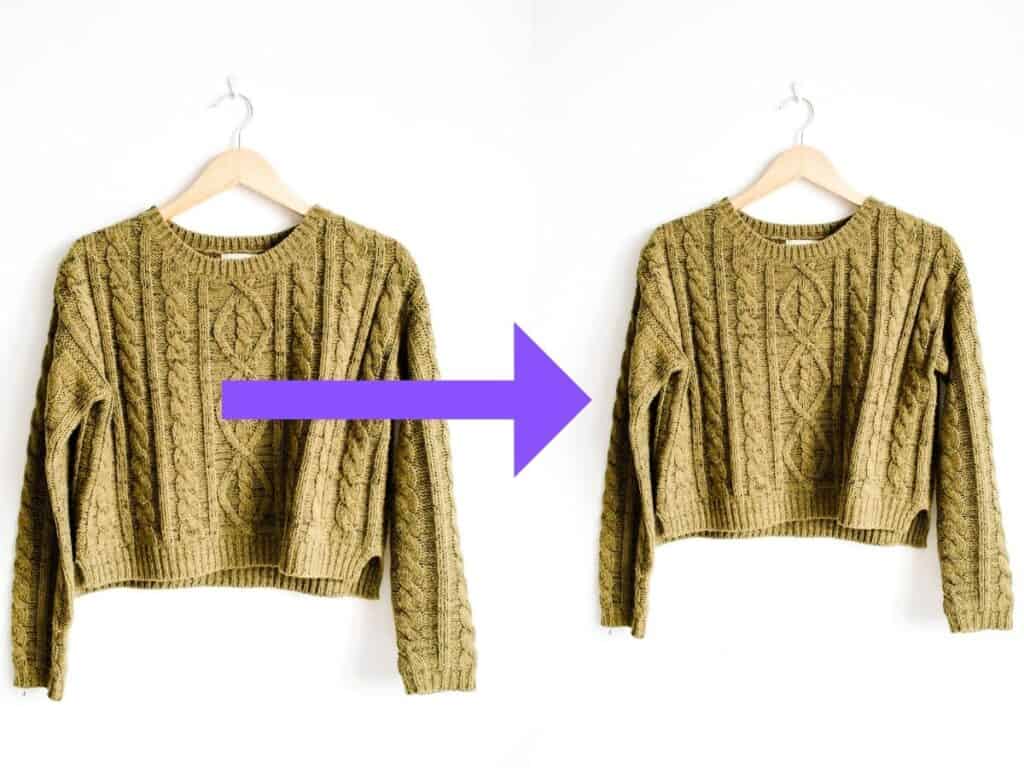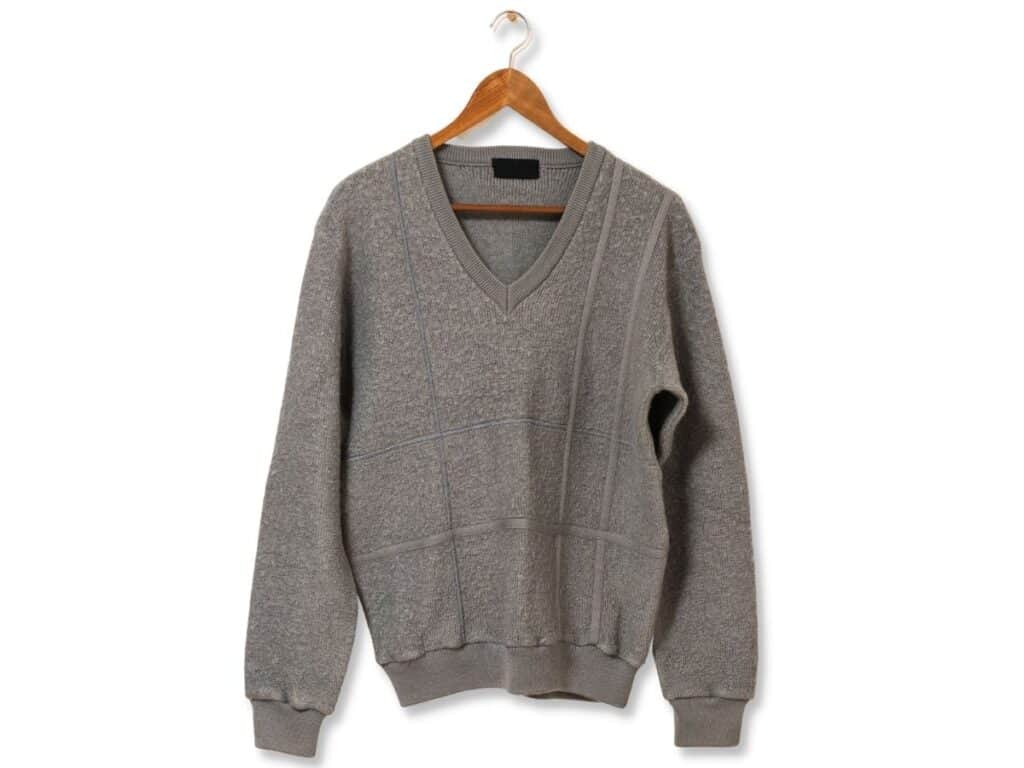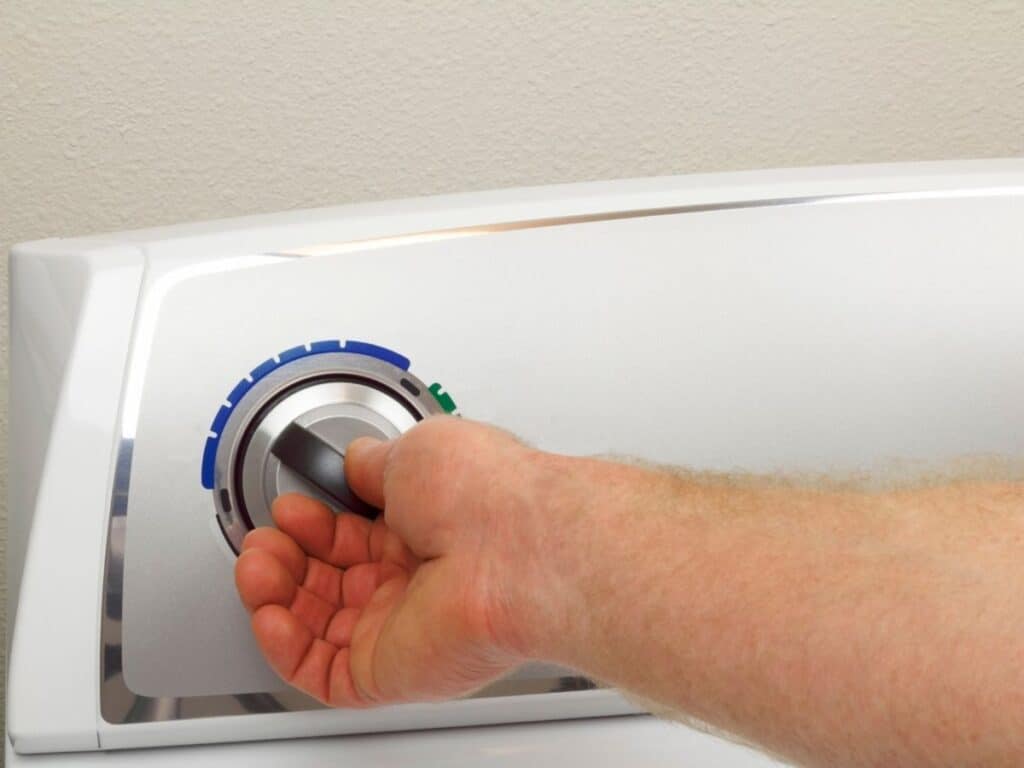Is your favorite sweater too oversized? Think of shrinking it if so. Being of the correct size will make it more appealing. But how do you shrink it?
You can shrink your sweater in the wash or by clothing alterations. Cotton and wool sweaters are the easiest to shrink. You can clean them using hot water and dry them in a dryer. However, wool sweaters should be dried on low heat to avoid over-shrinking.
How to Shrink a Sweater

There are a few methods for shrinking a sweater. The technique you decide on depends on how much fiber you wish to shrink in the sweater.
You can choose to shrink the entire sweater or just select areas. Wool, for example, occasionally only extends at the hems or necklines. So you have the option to choose to downsize specific areas while leaving the rest of the sweater alone.
Please be aware that choosing specific sections with cotton or synthetic fabrics may not work. This is because they react to shrinking differently and have slightly different characteristics from wool.
To choose the approach that will work best for you, look through our detailed instructions on how to shrink a sweater. We divided the instructions into the many fibers that your sweater might be composed of to make things simpler.
You will need:
- Your sweater
- Washing machine or large pan of boiling water
- Dryer
- Laundry bag
Shrinking Cotton Sweaters

Cotton is most likely the fabric that shrinks the least easily. Cotton clothing is notorious for shrinking when cleaned for the first time. One excellent illustration of this is denim jeans. The good news is that because your sweater is made of cotton, shrinking it will be simple.
Step 1: Use your washing machine’s hottest setting to clean your cotton sweater. After the cycle is complete, immediately place your sweater in the dryer.
Step 2: Tumble dry your sweater at a medium heat setting until it is moist. Then, iron the fabric using the cotton setting until it is totally dry. As you work, reshape the garment.
Shrinking Whole Wool Sweaters
A wool sweater can be shrunk in two different methods. Use the first technique on the list below if you need to shrink an entire sweater. Use the second to target particular regions of the sweater.
Pay close attention to how long you treat your wool sweater in both scenarios. Too much shrinking may result from using too much heat for too long.

Step 1: Choose a quick wash cycle and turn the heat up to high for your wool. You don’t want to feel it, so don’t go too high! As soon as your sweater’s wash cycle is over, move it to the dryer. When you want to shrink the entire sweater, this technique is perfect.
Step 2: Dry your sweater on low heat. Check on your wool sweater approximately every five minutes. You don’t want to dry it for an extended period. It might contract too much in the end.
Step 3: Remove the sweater from the dryer once satisfied with the amount of shrinking you have achieved.
Here are the best detergents to use for wool products.
Shrinking Part of a Wool Sweater
If you want to shrink specific areas of your wool sweater, proceed with these next steps. This technique works wonders when a shirt is stretched in particular places. It should also work on wool blends, provided that the garment is mostly made of wool.
Step 1: Put some water on the stove to boil. Use the water to dampen the cuffs, hems, or neckline, for example, where you want the garment to shrink. Only a minimal amount of water is required. It shouldn’t be drenched but slightly damp.
Step 2: If necessary, reshape the wet sweater portions. Then use a hairdryer with the maximum setting to finish drying. Dry the item further until all moisture has been absorbed or the shrinkage is satisfactory.
Do you know why wool has its distinct smell?
Shrinking Acrylic Sweaters
Acrylic sweaters are more challenging to shrink than wool or cotton sweaters. Although it is possible, your chances of damaging your sweater instead than shrinking it are two times higher. Additionally, any shrinkage you experience will be modest.
Step 1: Put a laundry bag with your acrylic sweater inside. Put the bag in a big pan of boiling water and then let it cook. Allow simmering for around 35 minutes.
Step 2: Remove the bag carefully, then roll it in a towel to drain any extra water. Be kind. The acrylic will be very fragile and simple to destroy.
Step 3: Place the item in the dryer without taking it out of the bag. Tumble dry the sweater for at least 15 minutes on the highest dryer setting. As soon as the cycle is over, take the sweater out of the dryer. The clothing will only be able to shrink as much as it can.
Shrinking Synthetic Sweaters
Shrinkage of synthetic materials can be challenging. They resist shrinkage due to their characteristics. The results might not be as good as reducing a natural fiber, but it is still doable. If synthetic fabrics contain a significant amount of natural material, such as cotton, they are more likely to shrink.
Additionally, you need to be aware of the synthetic material you use. Some people are more vulnerable to heat injury.
Step 1: To find out the sweater’s fiber content, look at the care label. Any sweater with a lot of natural fibers is likely to shrink.
Step 2: Use your washing machine’s hottest setting to wash the sweater. Put the sweater in the dryer as soon as the cycle is finished to prevent the synthetic fibers from melting, and dry on moderate to medium heat.
Step 3: Dry your sweater for about 15 minutes. If you exceed this timer, the synthetic fibers risk being harmed. If you are not satisfied with the results, you can repeat the downsizing process. But be warned that your risk of permanent harm grows with each treatment.
I also wrote a guide on how to stop sweaters from riding up that may interest you.
How to Shrink a Sweater Without Washing It
There is a safer way to wash and shrink your sweater. You can have the clothing size reduced by having it changed. Tailoring is what this is. You can shrink your sweater without washing it by taking it to a skilled sewist or tailor.
Changing your sweater has a lot of advantages. Re-sewing the seams, sometimes called “taking it in,” won’t harm the fabric’s fibers. It won’t even result in felting.
There won’t be any changes in the scale between the clothing and any stitching or embellishments. If your sweater is synthetic, there won’t be any unattractive shriveling either. The good thing with sewing is that you can apply this technique to both natural and synthetic textiles.
How much or how little the sweater is decreased is entirely up to you. Everything depends on your body measurements and the amount you want the seamstress to take it in. Even better, you can alter the sweater’s general design, for example, from a crew neck to a V neck.
You can make the adjustments if you know how to use a sewing machine. To make a sweater more form-fitting, follow our detailed instructions.
You will need:
- Your sweater
- Sewing machine
- Fabric marker
- Seam ripper
- Your body measurements
Step 1: Choose how much of your sweater you wish to wear. This can be accomplished by making adjustments to the garment’s side seams.
Step 2: Lay your sweater flat on a table after turning it inside out. Where you want the new side seam to be on your sweater, draw a line there. This ought to extend from the armhole to the hem.
Gently curve the line slightly inwards toward the center of the garment for a more form-fitting appearance, then back out as you get closer to the hemline. Keep in mind to give at least a half-inch seam allowance!
Step 3: The initial seam should be opened using a seam ripper. The garment should be readjusted to level the rough edges on the front and back. Use your sewing machine’s biggest stitch setting to sew the sweater back together. Tapping or basting is the term for this. Observe the line you have drawn.
Step 4: Test the fit of the sweater. It’s time to permanently stitch the seam if you are pleased with the outcome. Resew your temporary seam along the same line using an overlock stitch. Trim away any extra fabric. The permanent seam sewing phase can also be completed with a serger.
Can You Shrink Sweaters in a Dryer?

Sweaters can indeed shrink in the dryer. However, the amount of fabric in your sweater has a role in this technique’s effectiveness.
Some materials might shrink when exposed to dryer heat. For example, cotton and wool are suitable materials for shrinking in a dryer. Unfortunately, some textiles may melt in a dryer rather than shrink. If you place synthetic fibers in a dryer, you notice that they crinkle into unsightly ripples.
Pay special attention to the heat setting while drying sweaters to prevent shrinkage. Additionally, pay close attention to how long your sweater spends inside. Too much shrinking could occur from using too much heat for too long. Additionally, it raises the possibility of damaging your sweater.
I wrote a guide on how to hang sweaters without damaging them that may interest you.
Can You Shrink a Polyester Sweater?
Polyester can be shrunk up to a point. It won’t be as simple as shrinking cotton or wool. Additionally, the amount of shrinking you were expecting is less likely to occur.
Because it is synthetic, polyester is thought to be shrink resistant. 100% polyester has a built-in ability to maintain its shape and size, making it exceptionally difficult to shrink.
A polyester blend that has at least 50% natural material will shrink much more easily. The natural fibers shrink when it comes to mixtures, drawing the polyester strands in closer. The sweater will shrink more as its natural material content increases.
Why Would You Shrink a Sweater?
There are several justifications for wanting to shrink a sweater. The sweater is too big for you, which is the main reason.
The process of finding a sweater that fits is not always straightforward. Finding a sweater that fits you right away might be difficult, whether buying a new one or engaging sustainably by shopping at a thrift store.
It’s possible that you fell in love with a design or style that was only offered in a larger size. So you accept it since it’s a must for your wardrobe. In addition, oversized apparel is currently fashionable. You may make a fashion statement by going big.
One of the clothing items we prefer to layer is sweaters. No additional t-shirts or thermal vests can be worn underneath a perfectly fitted sweater.
Most people choose sweaters a little on the large side to accommodate extra clothes underneath, especially in cooler areas. Nobody enjoys being cold, so it’s wonderful to layer shirts underneath a sweater for extra warmth.
The issue with larger sweater purchases is a thin line between stylishly oversized clothes and clothing that’s just too big. Extra-large sweaters can make you look like a little child dressing up in their parents’ clothes. Anyone over the age of 12 should avoid dressing like that!
A smaller or two sizes of your sweater might help you look more attractive. Your appearance will appear more natural if the silhouette is more similar to your body size. You won’t seem sloppy from the sweater; on the contrary, you’ll look sophisticated.
Do Sweaters Shrink?
Yes. Sweaters shrink. More people than others can shrink. The sweater’s fiber content will determine how much it shrinks.
Natural fibers like cotton and wool tend to shrink readily. These two materials are recognized for their propensity to shrink. Even if they aren’t turned into sweaters. Particularly wool has a low tolerance for heat. Your wool sweater will shrink before your own eyes after a hot water wash and a brief spin in a warm dryer.
One of its drawbacks is that wool may quickly change from adult to child size. If you want the wool to shrink by a certain quantity, you must monitor it carefully. Or it will become small.
Synthetic-fiber fabrics are more difficult to shrink. Typically, synthetic content is resistant to shrinking. Natural fiber clothing occasionally has synthetic material added to it to reduce shrinking. However, even though it could be difficult, it is possible to shrink a synthetic sweater.
Can You Shrink a Sweater Without Ruining It?
Without being harmed, sweaters can shrink. However, it’s not as easy as it seems. The possibility of damage depends on the amount of fiber in the sweater, how well it is manufactured, and how you shrink it. You must proceed with caution to keep your knitwear safe.
Unfortunately, shrinking sweaters is not an exact science. Most of the time, shrinking a sweater is done by eye. This suggests that you examine the results after attempting to decrease them before evaluating them. You might need to use a different heat setting and stick to a different schedule depending on the sweater. No two sweaters shrink in the same way when it comes to shrinkage.
As a result, it could be difficult to shrink a sweater without damaging it, especially if it is constructed out of a delicate cloth or a substance that is susceptible to heat harm. But don’t panic; you can avoid destroying your sweater by taking a few precautions.
Be open-minded about the result as your first course of action. Don’t worry about striving to be perfect. You might not obtain the appropriate degree of shrinking. Remember the maxim “less is more.” Getting as close as you can is better than stretching your sweater too much.
Next, check your fiber content. Some sweaters have a greater ability to shrink without being harmed. Consider alternative strategies to reduce the amount of synthetic material in your sweater. For instance, tailoring can produce stylish, form-fitting garments without harming the fabric’s fibers.
Consider the sweater’s appearance as a third factor before attempting to shrink it. Does it have decorative elements or distinctive finishes? You are more likely to ruin your sweater with embroidery or applique. This is due to the fiber composition of the decorations. It’s possible that they won’t shrink with the sweater.
Next, you can check out my guide on how to fold sweaters, or my article on what material is best to use for pleated skirts.

I’m an expert wardrobe organizer and a bit of a clean freak. I created this website and its YouTube channel to share practical guides about laundry and organizing. My teachings have been featured in multiple large news publications, and I’ve self-published two wardrobe organizing books and an entire course on the subject.
